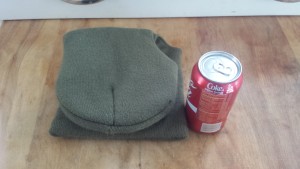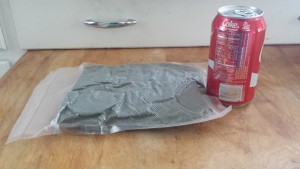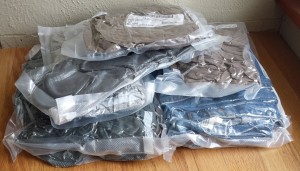Fella I know, who is getting started in the realm of preparedness had his birthday earlier this month. I got him what I think is one of the best gifts you can get a fellow survivalist: a vacuum sealer. For the record, the best gift you can probably get for a survivalist is a huge chunk of land in the middle of nowhere. For this survivalist, the best gift you can get is a slightly drunk and mildly self-esteem-challenged Jennifer Lawrence. Or, if you’re on a budget, her body double.
Thing is, most people have a very narrow view of what a vacuum sealer is good for. In fact, the gift was met with a ‘my freezer is already full’ response. A lot of folks, in my experience, don’t think creatively about the uses for one of these things that have nothing to do with food. So, lemme mention a few of the non-food things I do with mine and maybe it’ll send you down a new road of thought in regard to using yours. (Or getting one.)
- Compressing high-loft items of clothing so they take up less space in a pack


- Preventing powdered items from clumping – The cleanser that comes in the cardboard cans? I put each can into a bag and vaccuum seal it so that after years of sitting on the shelf it hasn’t drawn moisture and caked into a rock-like consistency.
- Water bottles that get left in the vehicle in the winter are vacuum sealed in a bag so if the plastic bottle does explode from freezing (which almost never happens) any leakage is contained. And the water is still potable.
- All the fire-starting materials in my hunting/bushwhacking packs are vacuum sealed to keep them dry, clean, and in one place.
- Small first aid items get vacuum sealed for rather obvious reasons.
- Critical documents are vacuum sealed so they are protected from moisture, wet, etc. For example, my birth certificate(s) and passport(s) are sealed up and sitting in the safe. (Uhm..yeah…plural….I know a guy…)
- In the Pelican case I keep in the winter vehicle kit there is an an entire change of clothes that has been vacuum sealed to consere space and keep the clothing clean and dry so that in an emergency it’s ready to use.

- Bulk first aid gear that would normally take up space gets vacuum sealed to allow me to pack more of it in a smaller space, as well as to protect it.
- Have a dog? Dog food MRE’s. Phydeaux’s kibble and treats packed into individual servings.
- Toilet paper that you keep in the truck or at the cabin. If you’re putting together a bugout bin or kit you really, really wanna make sure the TP is protected.
- Medications in tablet form. Most pills come in plastic bottles that offer good protection, but a lot of stuff comes in blister packs and although you’d think those foil and plastic sheets would offer good protection…not always. So, into the sealer they go. Try to keep stuff in original packaging when you do this…last thin you want is a little vacuum sealed bag of unidentified pills laying around with nothing to tell you what they are or how much to take. And the cops really get curious when large quantities of pills are loose in a plastic bag.
- Bars of soap. Bar soap seems to ossify over time. Seal ’em up so theyre still useful years later.
- Road flares. Seal ’em up, wrap in cardboard to protect the integrity of the plastic bag, and tuck ’em away in your vehicle. Wet flares are the literal damp squib at a rescue.
- Small electronics that absolutely need to be protected. Handheld radios get vacuum sealed with dessicant and then tucked away in a protective case of some kind. Suspenders and a belt, perhaps… but its an extra step that costs virtually nothing and makes sure that you have communications when you really, really need it. And thats worth pretty much anything.
- Batteries. Water and batteries do not mix..at least, not in a good way. I store batteries in plastic tubs but I also vacuum seal the large CostCo-sized bulk packs of batteries.
The list goes on, but I think you get the idea. And, yeah, they are also handy for food as well. If you haven’t bought one already, do yourself a favor and don’t cheap out. Yeah, there are some models that are $50-$75. Skip them. This is not the kind of item you want to cut corners on. Get the Foodsaver brand, not the Cabelas, not the Walmart, not the other brand you’ve never heard of. Get the Foodsaver branded rolls of material as well. Plan on spending about $200. I absolutely promise you that it will be the best $200 you can spend on preparedness gear. Do it.

Great primer !
Pro Tip: Absolutely, get the Food Saver. in fact, negotiate a deal for two. Then, get the accessories, plus spare accessories, and start customizing. A good oilless vacuum pump is also a useful tool, and if coupled with a sealer you can make bags just like the Food Saver, and it works great with mylar bags, some tubing and a hair straightener or curling iron. Not everything needs to be taken down to 30 inches of mercury, but a good vacuum pump can do that.
There’s much discussion on vac-sealing of ammo, best I’ve been able to learn is be gentle with it. There is air inside the cartridge case and vac-sealing will pull that air out over time. No biggie, but it means the vacuum inside the bag goes away. I do it with “field” ammo, stopping well before the vacuum gets heavy – what I want is the waterproofing.
You have to be careful about the air pressure inside the cartridge case being greater than the vacuum outside the case. I’ve seen bullets unseated from the shell casing after being vacuum sealed. A solid crimp will help, and cannelured bullets better still. But absolutely go easy with the vacuum.
Owned Foodsaver for years. On our 2nd one. Wore the first one out.
I pretty much do the same. But, you left out the best part. If you get a vacuum sealer you will invariably start to seal things just to see what happens. A few years ago, my boys and I took some vacuum sealed birthday cake camping. Yeah, you can guess what it looked like. It tasted fine. The boys were young, so we just called it astronaut cake and rolled with it.
I agree with you about a vacuum sealer being a great gift. A number of years back my daughter and SIL bought me a Foodsaver for Christmas. I can’t imagine how I did without one for so many years. Thanks for all the ideas about what to use it for besides food. There are a lot there that I never thought of. Just one minor quibble. While I do agree that you need to buy a high quality sealer (Foodsaver) and bags, I disagree about only using the Foodsaver brand of bags. I’ve tried a number of different brands of varying quality and found that Commercial Bargains available on Amazon to be the equivalent of Foodsaver. The only difference is that the CB bags do not have the white label strip. Well, one more difference. A 50 ft roll of CB is the same price as a 20 ft roll of FS. I’ve turned on a number of friends to them and everyone of them has been impressed. I gave out free samples at the range so that they could try before they buy and there wasn’t one that didn’t buy. Two of them even mentioned that they quit using their Foodsavers because the bags were too expensive and now they’re back to sealing. Just my two cents. Thanks again and keep up the great articles and info……………….
And, oh yeah, don’t forget. As you cycle your inventory, the bags can typically be reused if just used for dry storage and haven’t been exposed to rough handling.
Commander:
Dead right about vacuum-sealing batteries!
I seal 2 or 3 sets for a device and tape it to the item which I leave empty. If the battery dies it doesn’t take the device with it.
I know some things (for immediate use) should have the batteries in, but if you don’t have time to load the batteries, the situation is really SNAFU!
All the best…
I haven’t done the clothing, but medications, bandages, TP, cat food, and a couple of other things are definitely sealed up.
Done!
get the mason jar attachments for both wide and small mouth. good way to store dry packed food and dehydrated foods.
There you go, on about Jennifer Lawrence again….eeww! Can you at least wait til after b’fast?!?
There you go on, judging other peoples likes and dislikes again.
It’s only because I hold you in such high regard. You can do better. She make look like a movie star – but she sounds like Hilary Clinton.
Try to get that sound out of your fantasy…
Why, for goodness sake, would I let her use her mouth for talking?
Rule No. 1 – before you go to bed with a woman, make sure you like her voice because in the morning, she IS going to talk to you. A lot.
Wait…You let them stay the night??????
Haven’t gotten into vacuum sealing, you’ve definitely sold me on it.
Thanks
For your BoB, once you open a vac sealed bag, it’s pretty much done for…
UNLESS! You get these ziplock bags, that can be zip sealed after opening…
https://www.amazon.com/ShieldNSeal-Clear-Black-Heat-Zipper/dp/B01E94NUHC/ref=sr_1_7?crid=1E2SMG8L2INJF&dchild=1&keywords=vacuum+sealer+bags+zipper&qid=1593445274&sprefix=vacuum+sealer+bags+zip%2Caps%2C212&sr=8-7
My field medical supplies (bandages mostly, and gloves) get sealed in these…when I use them I can seal them back up (not as tightly, of course) and they are still protected from the environment. Also, when it’s time for an inventory check, the bags that haven’t been opened are full, right?
If you want the best, skip the Foodsavers. Yes, they will do just fine for years (depending/mostly), but top of the line is Weston. Pay once, cry once.
But i realize not everyone can do that and there is a valid argument of buying multiple OK items vs 1 Great item. Heck eg, my dad bought a Deere riding mower, services it like the factory says and it has lasted over 20 years and still going strong. i buy the cheapest Murray i can find, abuse the heck outta it for an average of 8 years then go buy anther one. So far, dad has spent more than i have on lawn mowing.
Theres an expression – quantity has a quality all its own.
I’ll throw my hat in the ring for VacMaster. Picked one up on sale a few years back and it’s been a champ. I like it better than my buddy’s FS, but it’s mostly preference. At any rate, if you’re in the market and find a good deal, I’d recommend one.
A foodsaver vacume sealer is around $90 on Amazon. Is that the one? You said around $200. Also do you have affiliate link for Amazon. Thanks
Shoulda been some linkage in one of those posts, but….https://amzn.to/3eVy8bq. And thanks.
FWIW, Costco puts the food saver on sale about every 3 months, and the box of rolls on sale about the same, although never at the same time…
Other people have recommended that rolls available from uline.com, but I haven’t tried them. With the periodic sales, and picking up rolls at estate and garage sales, I’m pretty well stocked up.
I’ll throw my support for vac sealing out there too. It makes a HUGE difference in longevity of frozen items. I eat meat I vac sealed and put in the deep freeze 5-7 years ago and it’s indistinguishable from some frozen last year.
Protip, some items will vac seal better if you freeze them first. I like to freeze hamburger in a mold to make one pound square slabs that fit nicely in the smaller bag size. Anything wet and soft can be done the same way. Freeze it first in a convenient shape, then vac seal.
nick
” I like to freeze hamburger in a mold to make one pound square slabs that fit nicely in the smaller bag size.”
GMTA, thats exactly how I do it.
When I make pasta sauce I’ll take bread loaf pans and line them with plastic wrap and then fill them with sauce. I then place them into a freezer until they are thoroughly frozen. Invert the pan, a touch of warm water and a nice brick shape chunk of pasta sauce pops out. THEN vac seal the brick and put it down for the cryo nap. When it comes time to use it I just drop the unopened vac sealed brick into boiling water and soon its ready to go.
Have a Cabela’s 15″ unit and have sealed with it for 7 years. Had to replace gasket due to operator error of leaving it locked in storage, a no-no. Good info.
Yep. I tend to keep an “emergency” puffy down vest around in the winter time and vacuum sealing means it stays dry and packs down to nearly nothing. My edc flashlight runs on a single CR123 battery and I keep a spare battery for it in my bag sealed up to keep it clean and dry.
Hey Mr. Zero you need to submit this excellent article to Survival blog. Haven’t seen this type of info in detail on the blog. Who knows you may win some great prizes. Very good useable information here.
Nah…professional courtesy.
Had a lesser FS but ran the snot out of it, just opened a #5 bag of flour from 2012 (yes you can do powders as long as none get in the machine) that is as good as new. For larger items(blankets,jackkets, sweaters) try the vacuum bags(HF) a whole winter/summer change of clothes compacts down very nicely and protects from dirt/moths/moisture(smoke when you have a fire) and can be hand rolled(or sit on) if no vac available(great for camping/ boating). No better way to store meat for freezer-you can add spices before sealing and get full flavoring(stew/taco/roasts). If you cut the bags a little long you can reseal them.
“Flour moths” are a real problem when anything grainbased in a box or bag comes into the house. Usually addressed by putting it in the freezer for a couple weeks. However when the “maggots” hatch out of the eggs layed by the moths they crawl “everywhere” in the kitchen and will chew through cardboard and plastic to lay eggs in unopened containers – breaking vacuum seals. Storing in glass jars has so far been the most successfully protective storage container. IME